You already know that shelterbelts can help you improve the health of your animals and improve yields.
You may also know that shelterbelts can help you reduce heat stress, prevent waterlogging and minimize fire risks. If not, please check this article out on farm shelterbelts.
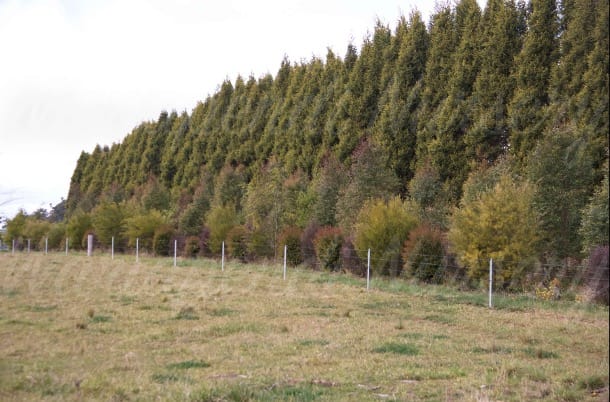
But how do you go about designing a shelterbelt? Where do you locate it? How many shelterbelts should you have? Which species do you use? How do you maintain them?
I know how daunting this can be. In this guide, I will simplify the key shelterbelt design points to help you create and manage your shelterbelts.
Getting your priorities right
First, let’s begin with your priorities. What do you want from your shelterbelts?
Are you prepared to maintain and water high-value shelterbelt trees that produce fruit and nuts? Or would you rather have native, drought-tolerant trees that need very little maintenance?
Perhaps you need your shelterbelts to deal with waterlogging. While on the other hand, you might want shelterbelts that can survive harsh summers without watering.
Or maybe you are willing to put in a few hours every of work every month to create beautiful shelterbelts with native shrubs, medics and flowers to increase the aesthetic appeal of your farm.
Whatever they are, be honest with yourself and write them down. Nail down your top three priorities. Remember, if you have more than three priorities, it is a wish list, and it is not very useful.
Locating shelterbelts
Shelterbelts can help you reduce evaporation, heat stress to animals and minimize fire risks. How? Because shelterbelts slow down hot, dry winds. Think about it.
Hot dry winds (and not just the intense sun alone) causes crops to dry up, heat stress and carries fire outbreaks along with it. When you slow down the cause, you also address these effects.
In Australia, we call this hot, dry summer wind the Brickfielder. It typically blows from the south. Depending on your local terrain and climate, this direction can vary.
It is essential to identify the predominant direction of this hot, dry summer wind in your region. Consult with your farm advisor and old-timers in your area. Ideally, you would want your shelterbelts to be perpendicular to your predominant hot, dry summer winds, to slow it down.
However, in reality, undesirable winds can come from multiple directions. So you could consider several belts to offer increased protection. But be careful, bad decisions might prove to be costly.
In addition to this, you can create shelterbelts in wet soggy places with water-tolerant species. You can also use hardy shelterbelt trees to amend parts of your farm that have poor soil. You can even use shelterbelts to cordon off unsightly views, wildlife and unwanted regions.
On the other hand, it might be challenging to establish shelterbelts in rocky patches, dry zones as well as on the highest parts of your farm. So proceed with caution.
For maximum benefit, you would ideally you would want a shelterbelt approximately every 250 to 500 meters on your farm.
Designing shelterbelts
Why? Because however much you try, you can’t permanently alter the direction of the wind. When you think about it, global weather patterns and humidity levels over our oceans create winds. So there are much larger natural forces at play here.
However, you can reasonably influence the wind directions for a short time, over a short area. So winds will eventually go over or around trees and other barriers, to continue on its journey.

The taller, the better
Several researchers, including Rowan Reid from the University of Melbourne, talk about how shelterbelts can reduce wind speeds by up to 50%, for an area within a specific range. This range is often expressed in terms of the shelterbelt height.
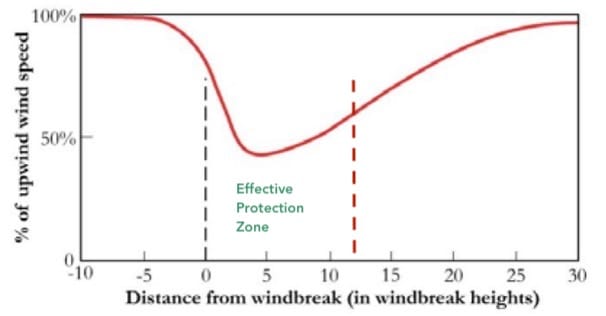
For example, let's say that the tallest trees in your shelterbelt are about 20 meters tall. A well-designed shelterbelt can effectively protect about 300 meters of the area from harsh wind speeds.
In other words, shelterbelts can protect an area that spans approximately 15 times its height.
The longer, the better
As explained earlier, obstacles such as trees, hills and buildings can only alter the direction of winds temporarily, before it can resume its journey back on the original path.
When you have only a few trees as a shelterbelt, strong winds will blow around it and converge back on the same path. So, you wouldn’t have slowed down the wind or changed its direction, long enough to give your pasture any benefit.
With short shelterbelts, you might even do further damage by causing the wind to move faster because of the wind tunnel effect.
Instead, it is better to plant long rows of shelterbelts. The longer the shelterbelts, the better it is.
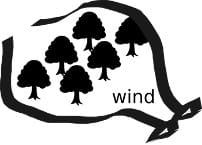
However, this creates a practical problem for your farm, when you want to get around your shelterbelts.
You don't want too much of a long detour around your shelterbelt. At the same time, you don't want to create wind tunnel effects. So, instead of straight roads, consider creating zig-zag pathways between rows of trees, as shown here.
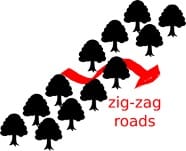
The more denser, the better
To prevent wind tunnelling effects, it is also essential to have more than two rows of trees in your shelterbelts. The more rows and the more densely they are planted, the better the results.
The more diverse, the better
Animals, birds and insects, in general, prefer certain kinds of habitat. When you plant your shelterbelts take care to include at least eight different species of trees, shrubs and plants.
This will make your shelterbelts less vulnerable to pest and disease outbreaks. At the same time, it will host a wide range of living creatures that make up a healthy ecosystem.
Spacing trees and shrubs within shelterbelts
In general, trees can be spaced about 3 meters apart. And rows of trees can be anywhere between 2 to 4 meters apart. However, in case you have different needs, you can also space them further apart.
Shrubs can also fill in the gaps between trees to create densely planted shelterbelts. You could even consider planting medics, aromatics and brassicas in your shelterbelts. This will double up as effective crop breaks that help you prevent significant pest and disease outbreaks in your pasture.
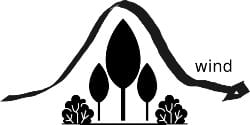
For maximum benefits, as shown here, plant your shortest shrubs and trees on the outer edges of your shelterbelt. And plant progressively taller species as you move towards the centre.
Selecting the right set of species and maintaining them
When it comes to selecting species, give utmost preference and plant more than half your shelterbelts with hardy native species. They will have the highest survival rates.
You can also plant a lot of high-value timber trees that have acclimatized well in your region. Be sure to ask your farm advisor, local forestry officers, and old-timers for advice on species selection.
Only after this should you even think about planting a few high-value trees for fruit, nut, or beauty. If you do so, plant them only in areas where you will be able to maintain them well.
Create a shelterbelt maintenance schedule on your farm. They might need a lot of maintenance and watering during the first few summers. Initially, weed control and fencing your shelterbelts are also equally important.
Make sure to take into account all these costs before starting out. You can also consider asking your farm advisor or neighbours about getting government funding assistance to plant trees on your property.
This brings us to an end. I hope you are convinced about creating shelterbelts on your farm. Like any other important thing in life, they do take a while before you see tangible benefits, but they are worth the long wait.
I trust that this information was useful to you. If so, please do share it with a farmer you know. If you have any questions about shelterbelts or about improving your pasture, let me know in the comments in below. I will personally answer them.
Happy Farming!
- The Dedicated Team of Pasture.io, 2020-04-16